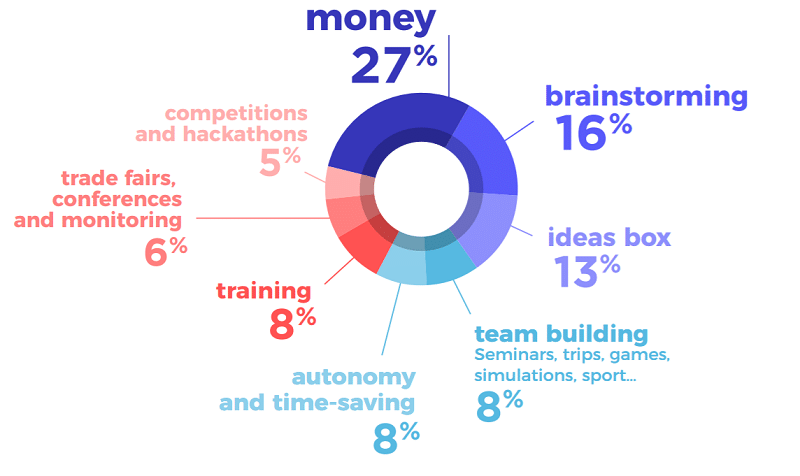
The Chatbot Observatory is publishing its third study, carried out at the end of 2018. For this new edition, dydu has decided to place innovation within companies in the spotlight. How do businesses perceive innovation, what strategies have they put in place to encourage it, what is their take on conversational bots, and what impact have these had on their everyday work life? These are the kind of questions put to a panel of respondents, all of them working for a department that promotes creativity within the company.
The Chatbot Observatory was created by dydu in October 2017. It aims to provide benchmarks for the different professions affected by the development of artificial intelligence systems, in particular chatbots, relating to their use within a professional sphere, and the prospects ahead.
Download the full infography of the 3rd edition of the chatbot observatory.
Innovation is seen as necessary for growth and survival
Innovation is an extremely vast concept, of which everyone has a different vision. This is confirmed by the variety of definitions given by the respondents. The majority (26%) consider innovation to be something new. We can’t disagree with that. For another quarter of respondents, innovation goes hand in hand with new technology. This reflects the importance of digital technologies in business development plans. 13% of respondents associate it with company’s products and services; innovation enables companies to create products and services with high added value, thus giving them a competitive edge on their market. 10%, partisan to an innovation strategy as opposed to one merely of improvement, believe that it ensures company longevity over time. Finally, 1 out of 10 respondents consider innovation to be at the service of mankind’s wellbeing; simplifying and improving people’s everyday lives.
Innovation is perceived differently by the respondents, but is more or less equally divided:
- 37% associate it with invention: the materialisation of a specific creative idea – for example, the invention of the car
- 31% consider it to be a significant improvement to an existing product or service – for example, the sportscar
- for 32% of respondents, innovation is simply a continuous improvement, a new development that enhances a product or service – for example, a new car model
Finally, innovation can be found at two levels:
- At an individual level: innovation improves work methods and tools, enabling employees to do more and better – optimise, create purpose, improve, simplify…
- At a company level: innovation allows to significantly improve a product, service or even process by meeting the expectations of a market it is conquering. It’s also generating wealth, whether technological, financial, environmental, societal or relating to image
A widespread culture of innovation in companies
For the majority of businesses, innovation is driven by an eponymous, cross-departmental hub (43%).
This is followed by General Management (24%), and then IT (21%). 3 companies out of 5 have implemented strategies to encourage innovation amongst their employees. This is even more true for the private sector (64%) compared to the public sector (48%). It is also interesting to note that the culture of innovation is more widespread in medium-sized companies (70%), as opposed to large (56%) or small ones (43%).
Amongst the different strategies put in place to encourage innovation, implementing a reward system is the most popular:

Finally, over half of the respondents consider that the failure of an innovative project is valued in their company and allows to reduce the failure rate of future projects. This is true for the majority of executives and directors (respectively 58% and 69%), whereas 37% of non-executives do not share this opinion.
So where do bots come into play?
Different types of bots were evaluated in this study: chatbots, callbots and voicebots
Each one is perceived as innovative, with an average of 3.1 for the chatbot, and slightly higher for the other two (3.2). All respondents agree (78%) that the advent of bots is inevitable! For 74% of them, bots even constitute a lever for a company’s digital transformation.
31% of companies surveyed have already implemented at least one bot. This falls in line with the two previous studies of the Chatbot Observatory, in which 42% of marketers and 23% of HR professionals had deployed a bot. Amongst the companies equipped with these tools, the chatbot remains the most popular (63%), followed by the voicebot (29%) and the callbot (8%). For this, they call upon:
- A software publisher (43%)
- A digital agency (26%)
- An Open Source platform (14%)
- Their own internal developers (9%)
- An integrator or IT company (8%)
Benefits linked to productivity are the most frequently observed (59%), followed by time saving (29%) and customer satisfaction (8%).
Amongst the companies not yet equipped with these tools, callbots are favoured (+5pts) more than in those already equipped. Customer satisfaction (+6pts) and image (+8pts) benefits are hoped for above productivity. Finally, 57% would like to implement bots for their customers, and 43% for their internal teams. The same ratio, in fact, that can be observed amongst dydu’s clients.
Methodology
The ‘Institut Occurrence’ carried out this third study between the 10th and 21st of December 2018 amongst 310 professionals from General Management, IT, Research & Development, Marketing or Innovation departments in France. All company sizes and levels of responsibility were represented, including directors (21%), executives (57%) and operational employees (22%). The margin of error is +/- 6 points (i.e. for a result of 50%, the accurate result lies somewhere between 44% and 56%).





